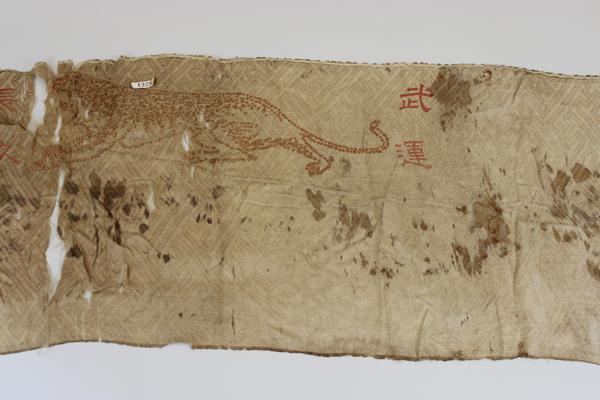Japanese flag
Accession Number NWHRM : 1329
Description
Japanese textile taken by the donor from a Japanese soldier during the Battle of Kohima, May or June 1944. It is probably a senninbari, a belt sewn by women with 1000 stitches and given to Japanese soldiers as a token of protection and good luck. The donor is Mr A. Clarke, who served with A company, 2nd Battalion, Royal Norfolk Regiment. In the centre, a design of an animal - probably a tiger - is stitched in gold-brown thread. Around the edges of the tiger, four Japanese characters are painted on in red. There are several bloodstains present along the length of the material. The Battle of Kohima took place in North-East India in April-June 1944, during the Burma Campaign of the Second World War, when forces of the British Army - including Indian and African troops - successfully turned back a Japanese offensive which had aimed to penetrate further into India.
Read MoreJapanese flag
This large textile was taken from a Japanese soldier during the Battle of Kohima (April-June 1944) by Mr. A. Clarke, a member of the Royal Norfolk Regiment. It is probably a senninbari, a belt sewn with 1000 stitches and given to Japanese soldiers as a token of protection and good luck when they went away to war. Traditionally, a soldier's wife or relatives would stand in a busy space like a train station or temple and ask passing women to contribute one stitch each to the design, except for those born in the Year of the Tiger, who could provide either twelve stitches or as many as their age.
Imperial Japanese soldiers also frequently carried a 'hinomaru yosegaki' - a national flag signed by friends and family, often featuring short messages wishing them victory and good luck. These deeply personal objects are a poignant reminder that for every casualty, there was a group of loved ones eagerly awaiting their return, for whom life would remain forever altered long after the war had ended.







